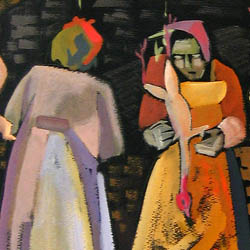"The best way to appreciate your job is to imagine yourself without one."
~ Oscar Wilde
Welcome to AT WORK, a digital exhibition presenting and exploring images of labour in 20th century Saskatchewan. The exhibition was produced by the University of Saskatchewan Archives in partnership with archives throughout the province.
As Beth Bilson, legal scholar, has recently noted, Saskatchewan "conjures up waving wheatfields, not smokestacks; grain elevators, not factories. The history of labour in Saskatchewan has not been the subject of extensive study. It is a subject that repays closer examination, however, for it reveals that, as with many aspects of the political, economic, and social history of the province, this history has features that mark it as distinctive and unique in Canada." ['Perspectives of Saskatchewan (2009), p. 197']. Contradicting the province's agrarian stereotype in June 2009 the Saskatchewan Ministry of Advanced Education, Employment and Labour reported that the provincial labour force of 557,500 included 140,400 employees working for salaries in the public sector and an additional 294,900 in the private sector. Only 44,400, less than one tenth the total number of workers, were employed in agriculture.
To provide manageable limits we were guided by definitions of labour as "the social class who does manual or physical work for wages" and "productive, especially physical, work done for wages." Beyond our scope was the very considerable work of farm owners, who frequently wish to be seen as small business operators, providing both capital and management skills, in the pursuit of profit. Similarly there is no attempt to document here the unpaid work, usually done by women, in their homes. We have not sought to highlight the work of those working in professions, although many are paid wages for their work.
Within these parameters we have attempted to show how varied waged work has been in Saskatchewan and to describe how economic and social conditions have affected employment. Some of the images have been selected to suggest how issues of race, ethnicity and gender, have influenced labour.
The reproduced images were discovered at several of Saskatchewan's largest archives including the Regina and Saskatoon offices of the Saskatchewan Archives Board, the City of Saskatoon Archives, and the Special Collections unit of the University of Saskatchewan Library. The Local History Room of the Saskatoon Public Library was a particularly rich source of images, as was the University of Saskatchewan Archives, which, in addition to documenting the history of the University, preserves the very extensive records of the Saskatchewan Wheat Pool, once one of the province's largest and most influential employers.
We were happy to uncover hundreds of intriguing and/or dramatic photographs that described and evoked Saskatchewan's labour past. However only a few of the discovered images predated Saskatchewan's achievement of provincehood in 1905. Since the selection was made from archival collections already acquired and processed, there are consequently few depictions of work and work sites from the most recent decades.
It was our determination to give preference to previously unpublished images and to include photographs from a variety of Saskatchewan communities and from different historical periods.
How well or how badly have the occupations of the working class been documented by archives, better known for recording the achievements of our political, economic and artistic elites? The conclusion is mixed. A cursory exploration suggests that some occupations - e.g. firefighting, police work, custom threshing, mining and lumbering- are well represented. On the other hand only a handful of images of newspaper boys, hired men and girls, and cleaners and sanitation workers were discovered.
Visitors to the site can interact with the material in various ways. To highlight some of the most interesting images and to give very brief context, a small selection of the scanned images have been included with text on theme pages. The much larger and complete collection of images can be searched independently by exhibition themes, occupations, keywords and dates. The 'merely' curious can select from a random presentation of images.
A bibliography of both print and digital resources concerning Saskatchewan labour history is available, including access to full text copies of several articles and theses. Professor Joe Cherwinski has generously provided an educational resource to provide more context to the images.
We hope that our exhibition shines new light on the history of work in Saskatchewan. It is our especial hope that AT WORK will act as a mirror for current workers, directly linking their current situations and challenges to the experiences of those who have gone before.




